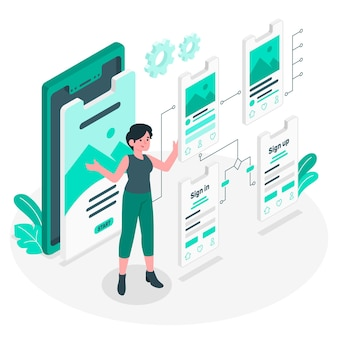
In web design, user interface (UI) and user experience (UX) are crucial components. UI/UX designers are responsible for ensuring websites look good and are easy to use. If you’re interested in becoming a UI/UX designer, it’s important to know the basic skills required for the job. In this article, we’ll discuss some of the key skills you need to be successful as a UI/UX designer.
The UI/UX designer must have a portfolio that showcases their key skills to get ahead in the industry. These include user research, wireframing, and visual design or mobile apps for explanation purposes. They’re not always easy to prove through just one project alone.
The interfaces we see today are much more engaging than they were before. With the growth of technology, mobile application developers and UI/UX designers have become essential to every company to develop apps and keep up with their competition by coming out on top.
What is UI/UX Designing:
A UI is an interface, while a UX is a user experience. UI/UX design focuses on creating user-friendly products. Products must be visually appealing and highly pleasant to interact with, making them perfect for people who want easy-going things on their machines or devices.
There’s a common misconception that UI and UX come down to the same thing, but they’re not entirely true. They both focus on aspects of your customer’s journey with digital products, making them pretty important. A user persona’s goal is to understand your users’ needs and preferences, so you can create an experience that meets their goals.
The UI/UX designer course will teach you how to design user interfaces that are aesthetically pleasing and easy for people with different levels of expertise. You’ll learn the importance and benefits of research-backed design methods and important design tools.
Difference Between UI & UX:
UI Design is the fundamental building block of any digital product. It focuses on visual factors like buttons, fonts, and color schemes to create an aesthetically pleasing user interface for your customers/readers, making them want more.
UX is the key to creating an awesome product design. The best UX designs enable seamless goal achievement for users and ensure they have a great experience.
Imagine a car engine. The UX would be its mechanics, like power and transmission type, while UI is aesthetics, such as livery, paint, or the vehicle’s dashboard.
Basic Skills Required To Become UI/UX Designers:
There’s no clear-cut path toward becoming a UI/UX designer. Many professional designers come from unrelated fields and bring transferable skills such as visual communication, software engineering, or digital marketing to the table. A UI/UX designer needs to possess the following skills.
1. UX Research Skills:
UX designers rely heavily on research and analysis to understand the needs of their users. They can interview people, observe them in action, or use usability testing methods like surveys /focus groups. This helps UI/UX designers improve user experience without much effort.
Often, when designing for mobile devices, user experience is overlooked. 85% of issues can be detected by performing a usability test on five users, according to Measuring U.
Their jobs involve creating the perfect survey questions to ensure that they do not direct or mislead anyone while also understanding usability test methods for their designs will be successful.

2. Wireframing & Prototyping Skills:
Wireframes are an important part of the user interface design. They help design elements like images, menus, and CTA buttons are denoted in diagrammatic form so they can easily flow together on key pages with no mistakes or confusion about what should go where.
A UI/UX designer creates a product’s user interface and user experience, which is used to test processes or ideas. They must be familiar with prototyping tools like Photoshop to produce this high-fidelity design at phase four as final mockups that resemble what will eventually come out when coded into software programs on completion. It takes skillful artistic talent and patience because they cannot start coding until all phases have been completed perfectly.
3. UX Writing Skills:
UX writing is designing, crafting, and executing words that create an optimal user experience. UX writing is a specialized form of content marketing that helps design and craft user experiences through microcopy.
UX specialists are very important to ensure the website or app has everything it needs for people who use them by providing clear navigation menus. Interesting content with helpful information on how best to utilize what you’re looking at while reflecting your brand values so everyone can understand where they stand when interacting via these digital products.
4. Visual Communication Skills:
Visual design in UX is much more than what you see on a website, although it does include how things look and feel. When users encounter standardized UI elements such as hamburger menus or even playback buttons, they instantly know where to click without having any other clues about their purpose besides color schemes.
A professional visual communication skill set is not just about using pictures. And it’s also important to minimize the need for written instructions and show users where they should go next. This can be done by providing a clear graphical user interface design, which proves as a visual element or helps texts that explain what action will take place when performing certain functions on your website, so there are no unwanted surprises.

Freepik
5. Interaction Design Skills:
Successful digital products are designed with intuitive interaction design that enables users to complete desired tasks in the least amount of time. This includes aesthetics, motion, sound, or physical space (where your product is used). Considering how these affect users’ interactions will help them accomplish their goals without too much difficulty.
The appearance of your website or application can greatly impact how credible it appears. 75% of consumers will form their opinion based solely on the site’s aesthetic appeal.
6. Coding Skills:
UI/UX designers should have a basic understanding of coding to make minor website changes without going through the entire design process. UI and UX designers will collaborate better with software engineers by working from designs made using HTML and CSS knowledge. They also need other UI UX designer skills like sketching ideas or even collaborating on google docs instead of forgoing individual emails, all because it’s easier than ever before.
7. Analytical Skills:
Essentially, a product designer aims to make your designs easy for users and customers to interact with. It is possible to do this by observing what they do or how long it takes them to complete a task. You need only understand numbers well enough so that the performance metrics give insights into where improvement may lie within an interface design. This will help drive better products from inception.
8. Typography Skills:
A designer’s typography skills are crucial for user experience design. The right font will make the difference between an attractive and effective website, app, or any other type of digital media that requires attention-grabbing qualities to be successful.
9. Information Architecture Skills:
The content strategy for your company’s website is a key component of the user experience. It involves thinking about how users will explore and interact with information on-site and what they need from you to succeed, especially regarding complicated software applications like chatbots or web pages that require more than text input.
UI/UX Designer Interpersonal Skills:
An important aspect of UI/UX design is considering how users interact with the interface and their experience. Soft skills such as presentation, attitude (including leadership qualities), and communication abilities are all vital aspects of a UI Design team that need attention when considering candidates for employment or graduate school programs.
A Full Stack course is the ultimate way to understand UI/UX design and web development. You’ll be able to build your websites, apps, or other digital products from start to finish with this rigorous but rewarding curriculum.
a. Curiosity:
UI/UX designers should be curious about what makes the users tick. Suppose they want more thoughtful questions and insights. In that case, it’s time for them to start understanding people with different needs or desires from themselves to provide a better experience overall.
b. Empathy:
UI/UX designers are the ones who break barriers, assumptions, and biases for users to feel comfortable with their experience. These professionals have empathy that any other person cannot match. Helping people reach their needs without being distracted or judged is what they are passionate about. This makes UI UX designers perfect champions of all we do at our company.
c. Communication:
UI/UX designers are not just in charge of creating the look and feel of an app and how it’s used. They must be persuasive, well-spoken, and able writers to communicate successfully with the many different people they come across throughout their jobs. An effective designer can do this by using research skills as a foundation of their argument so it is clear why certain decisions were made about what design solutions would work best based on customer needs.
d. Flexibility:
UI/UX designers must remain open-minded and focus on research findings. They should ask open-ended questions, be prepared to change when new information comes in, especially if it contradicts earlier studies or assumptions, know how much flexibility they have with respect for different people’s needs, and stay professional.
Conclusion:
To succeed, UI/UX designers need a solid grounding in graphic design and user experience. A career in UI/UX design is both challenging and rewarding. The ability to think from a user’s perspective and combine creative and technical skills are required.
The basic principles and concepts of UI/UX design can be learned if you consider a career in this field. Then, practice your skills by designing mockups and prototypes for real-world scenarios. The more experience you gain the better prepared you will be to take on future challenges in this rapidly growing industry.
